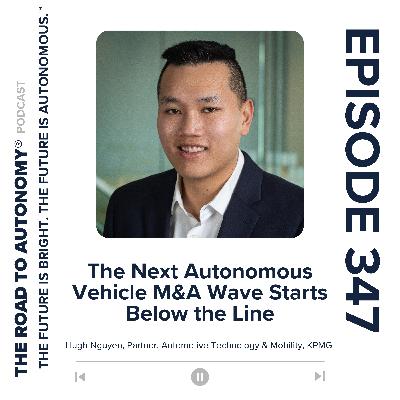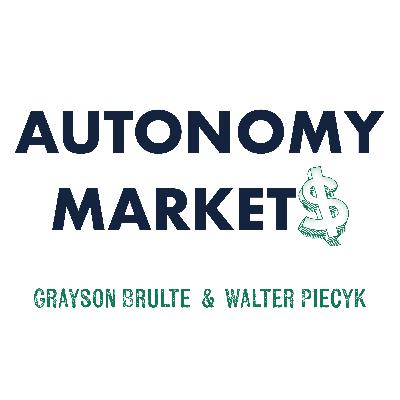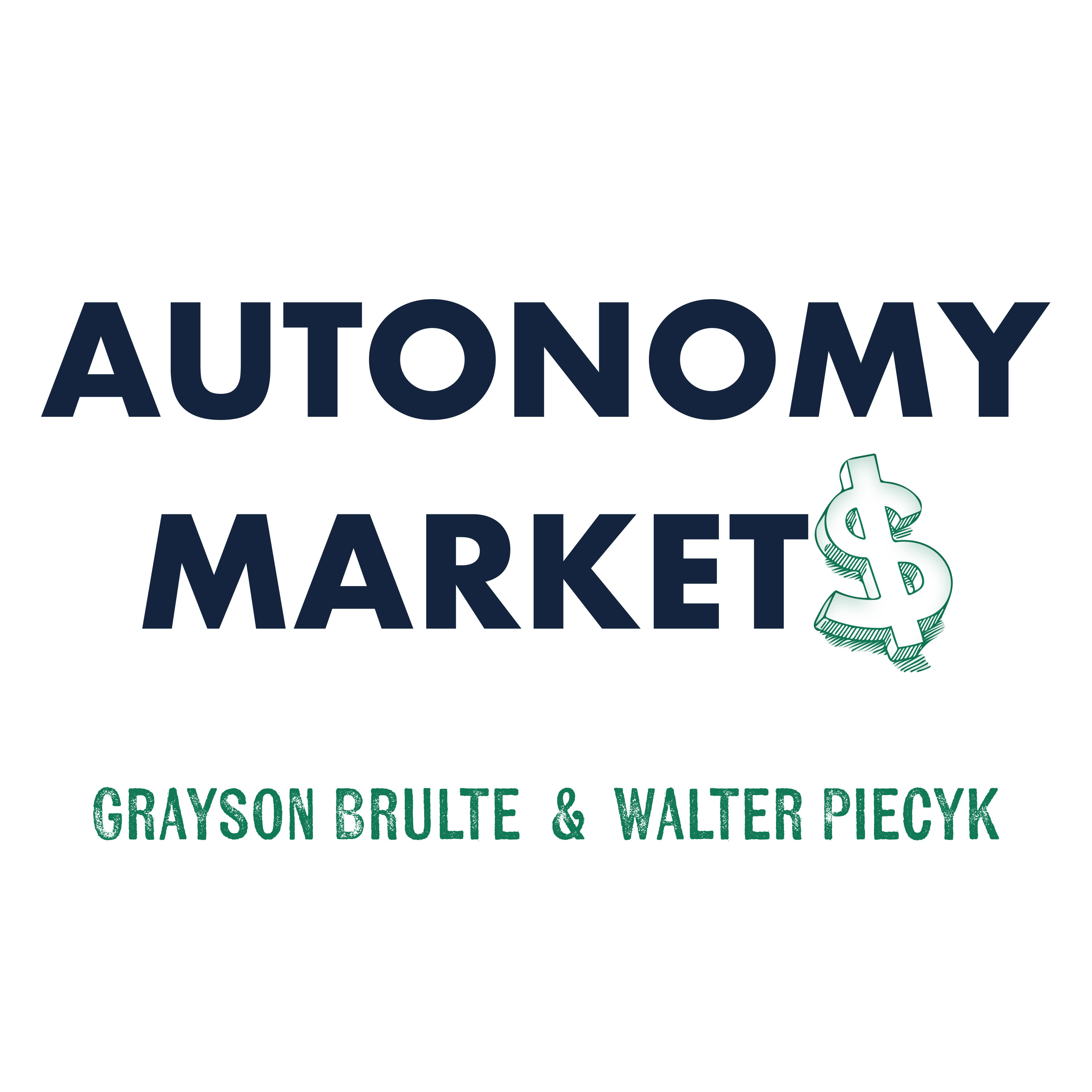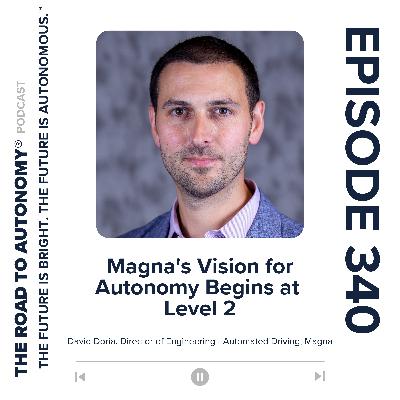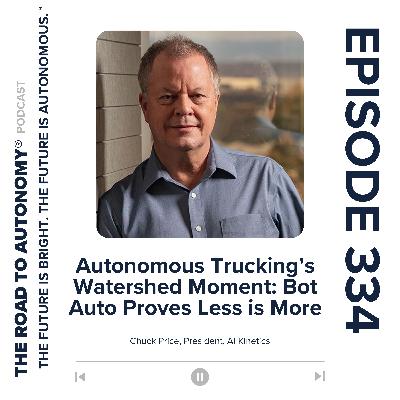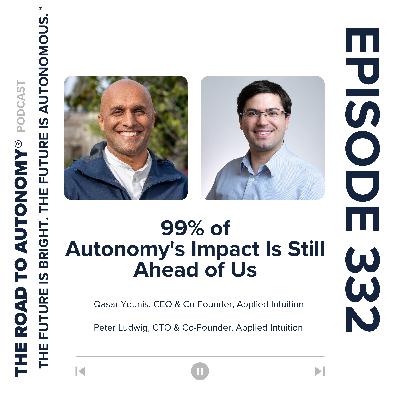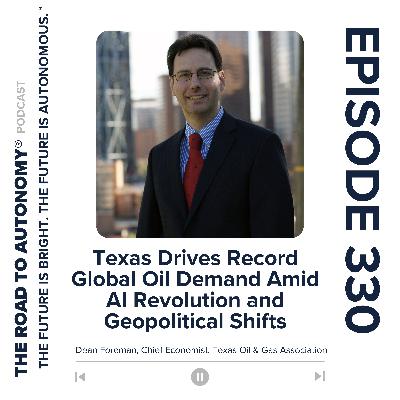Discover The Road to Autonomy
The Road to Autonomy

The Road to Autonomy
Author: Grayson Brulte
Subscribed: 35Played: 1,429Subscribe
Share
© 2024 The Road to Autonomy LLC | All Rights Reserved
Description
How would you feel if the transport truck beside you on the highway had no driver? Or the car passing beside you had no driver? Would it make a difference if the widespread deployment of autonomous trucks could ease supply chain problems almost overnight and that autonomous vehicles do not get distracted or speed? And would you feel better if you knew autonomous trucks and vehicles could reduce carbon emissions by 30 percent or more. Learn more from world's leading mobility experts on The Road to Autonomy®, an ahead-of-the-curve podcast hosted by Grayson Brulte.
347 Episodes
Reverse
Hugh Nguyen, Partner, Automotive Technology & Mobility, KPMG joined Grayson Brulte on The Road to Autonomy podcast to discuss the emerging wave of autonomous vehicle partnerships, the hidden value in fleet operations, and the coming M&A consolidation that will reshape the industry.As the autonomous vehicle ecosystem accelerates through a phase of rapid partnership formation, the real value lies “below the line” with fleet operations, depot management, safety protocols, and operational expertise that rarely makes headlines. While the market fixates on vehicle counts and technology partnerships, the proprietary knowledge of how to actually deploy and scale robotaxi operations at profitable unit economics represents the true competitive moat. Hugh predicts the next 18-24 months will see continued partnership proliferation across global markets, followed by strategic consolidation driven not by headline M&A deals, but by precision talent acquisition and operational capability roll-ups. The winners will be those who control fleet operations, understand regulatory navigation, and can scale profitably. Capabilities that are increasingly attracting investor interest as the industry matures beyond the cult of the founder and towards operational excellence.Episode Chapters0:00 KPMG's Thoughts on Autonomous Vehicles 6:04 Autonomous Vehicle Partnerships 15:31 Emerging M&A Activity 23:48 What Happens When a Partnership Doesn't Work?25:47 Autonomous Vehicle Fleet Management 31:45 Autonomous Vehicle Asset Rollup 40:10 The "Passport" Model 47:17 Cult of The Founder48:54 M&A OutlookRecorded on Thursday, November 6, 2025--------About The Road to AutonomyThe Road to Autonomy provides market intelligence and strategic advisory services to institutional investors and companies, delivering insights needed to stay ahead of emerging trends in the autonomy economy™. To learn more, say hello (at) roadtoautonomy.com.Sign up for This Week in The Autonomy Economy newsletter: https://www.roadtoautonomy.com/ae/See Privacy Policy at https://art19.com/privacy and California Privacy Notice at https://art19.com/privacy#do-not-sell-my-info.
This week on Autonomy Markets, Grayson Brulte and Walter Piecyk discuss Waymo’s great highway unlock, their Bay Area expansion to 260 square miles and the launch of commercial service at the San Jose Airport.Despite the expansion, Waymo remains sharply vehicle-constrained. Bloomberg reported this week that the company is operating roughly 1,000 vehicles in the Bay Area, 700 in Los Angeles, 500 in Phoenix, 200 in Austin, and just 100 in Atlanta, for a total fleet of approximately 2,500 vehicles spread across all markets.In the autonomous trucking market, Kodiak continues to demonstrate that the economics work. With 10 fully driverless trucks generating revenue in the Permian Basin, the company logged 5,200 paid hours last quarter, up 166% from Q2, a meaningful validation of the model.Wrapping up the conversation, Grayson and Walt examine why technology leadership means nothing without scalable manufacturing partnerships and now how autonomous trucking is pulling ahead of robotaxis on business model execution, and what global expansion in Abu Dhabi and Singapore signals about the global competitive landscape.Episode Chapters0:00 Waymo Expands to Highways3:58 Vehicle Supply16:56 California Airports19:28 Tesla FSD Update21:42 Uber Ski25:21 Kodiak29:40 Foreign Autonomy Desk30:40 Next WeekRecorded on Thursday, November 13, 2025--------About The Road to AutonomyThe Road to Autonomy provides market intelligence and strategic advisory services to institutional investors and companies, delivering insights needed to stay ahead of emerging trends in the autonomy economy™. To learn more, say hello (at) roadtoautonomy.com.Sign up for This Week in The Autonomy Economy newsletter: https://www.roadtoautonomy.com/ae/See Privacy Policy at https://art19.com/privacy and California Privacy Notice at https://art19.com/privacy#do-not-sell-my-info.
This week on Autonomy Markets, Grayson Brulte and Walter Piecyk discuss Waymo’s expansion into three new markets, Uber’s role in autonomy and Lyft’s growing infrastructure ambitions. Beneath the headlines, Tesla is aiming to once again reshape the entire autonomous driving industry with their AI5 chip, FSD Unsupervised deployment, and the expansion of their insurance business. As Tesla continues to focus on what’s next, Uber is sending mixed messages to the market while engineers across Silicon Valley begin exploring alternatives to Nvidia’s GPUs. Wrapping up the conversation, Grayson and Walt discuss what happens when the world’s largest autonomy players diverge on strategy and long-standing partnerships begin to falter.Episode Chapters0:00 Waymo’s Three City Expansion 2:11 Waymo & Uber’s Relationship 4:21 Managing Robotaxi Fleets14:56 Robotaxis at Airports 16:40 Uber’s Autonomy Messaging Strategy 23:12 NVIDIA and the Growing Demand for new Chips25:45 Applied Intuition 28:19 Tesla37:14 Foreign Autonomy Desk40:02 Next WeekRecorded on Friday, November 7, 2025--------About The Road to AutonomyThe Road to Autonomy provides market intelligence and strategic advisory services to institutional investors and companies, delivering insights needed to stay ahead of emerging trends in the autonomy economy™. To learn more, say hello (at) roadtoautonomy.com.Sign up for This Week in The Autonomy Economy newsletter: https://www.roadtoautonomy.com/ae/See Privacy Policy at https://art19.com/privacy and California Privacy Notice at https://art19.com/privacy#do-not-sell-my-info.
This week on Autonomy Markets, Grayson Brulte and Walter Piecyk discuss NVIDIA’s ever expanding autonomy ambitions and the fracturing relationship between Waymo and Uber, which may signal the end of one of the industry’s most-watched partnerships. Jensen Huang’s latest GTC announcements further signaled that NVIDIA is moving beyond supplying compute to potentially building their own full autonomy stack and licensing it. Grayson and Walt trace this shift back to the early days NVIDIA’s automotive division and the evolution of its Hyperion platform, which is now positioned not only to power OEMs but also to compete directly with the very companies that rely on its GPUs to enable autonomous driving systems.While NVIDIA appears poised to compete with its customers, Waymo and Uber’s partnership is showing signs of unraveling after Uber announced plans to deploy Lucid/Nuro autonomous vehicles in San Francisco next year, directly challenging Waymo on in their home market.Grayson likens the move to “divorce court,” raising questions about how the companies will divide the Austin and Atlanta markets, where Waymo currently operates exclusively on Uber’s platform. The episode closes with updates on Aurora’s strategic pivot and the Foreign Autonomy Desk, covering Baidu’s expansion in Hong Kong, Uber’s European ambitions, and continued progress in Tesla’s FSD rollout.Episode Chapters0:00 NVIDIA's Autonomy Ambitions 7:13 Waymo & Uber's Fracturing Relationship9:35 Nuro's Upcoming Launch on Uber in San Francisco 11:51 Gemini is Coming to Waymo14:05 Boston's Autonomous Vehicle Blunder15:43 Seattle's Challenging Political Environment 17:34 Political Coalitions 19:36 Aurora's Pivot25:32 Tesla Robotaxi / FSD 14 Updates30:04 Foreign Autonomy Desk33:08 Next WeekRecorded on Thursday, October 30, 2025--------About The Road to AutonomyThe Road to Autonomy provides market intelligence and strategic advisory services to institutional investors and companies, delivering insights needed to stay ahead of emerging trends in the autonomy economy™. To learn more, say hello (at) roadtoautonomy.com.Sign up for This Week in The Autonomy Economy newsletter: https://www.roadtoautonomy.com/ae/See Privacy Policy at https://art19.com/privacy and California Privacy Notice at https://art19.com/privacy#do-not-sell-my-info.
David Welch, Detroit Bureau Chief, Bloomberg joined Grayson Brulte on The Road to Autonomy podcast to discuss GM’s return to autonomy and the company’s long-term strategy for personally owned autonomous vehicles.As GM once again re-enters the autonomous vehicle market, the company is signaling a new chapter, one centered on developing a hands-free, eyes-free driving system under the leadership of Chief Product Officer Sterling Anderson, beginning with the 2028 Cadillac Escalade IQ.GM’s evolution from Super Cruise to a fully realized personal autonomy platform represents more than a technological shift; it marks a strategic transformation in how the company approaches safety, profitability, and consumer trust. The automaker is rebuilding its autonomy strategy through a sharp focus on profitability, disciplined execution, and a renewed commitment to integrating autonomy into vehicles that consumers can own and enjoy.Episode Chapters0:00 The Road to Autonomy Introduction0:23 GM's Renewed Autonomy Strategy 7:00 Super Cruise 11:35 Hands-Off, Eyes-Off16:04 Policy19:14 China23:10 Hyundai IONIQ 5 Platform 25:30 Contract Manufacturing and Licensing 32:03 GM's New Computing Platform 40:46 GM in 2030Recorded on Friday, October 24, 2025--------About The Road to AutonomyThe Road to Autonomy provides market intelligence and strategic advisory services to institutional investors and companies, delivering insights needed to stay ahead of emerging trends in the autonomy economy™. To learn more, say hello (at) roadtoautonomy.com.Sign up for This Week in The Autonomy Economy newsletter: https://www.roadtoautonomy.com/ae/See Privacy Policy at https://art19.com/privacy and California Privacy Notice at https://art19.com/privacy#do-not-sell-my-info.
This week on Autonomy Markets, Grayson Brulte and Walter Piecyk discuss Tesla’s Q3 earnings call, NVIDIA’s strategic partnership with Uber, and GM’s surprising return to autonomy under Sterling Anderson’s leadership.The conversation opens with Walt’s firsthand insights from Tesla’s Q3 2025 earnings call, where the company confirmed plans to remove safety attendants across “large parts” of Austin by year-end after accumulating 250,000 robotaxi miles.Tesla also announced 8–10 additional markets coming online by year-end, including Florida, Arizona, and Nevada, following the company’s phased rollout playbook: safety-attended operations first, followed by fully autonomous service. Grayson projects more than 300 Model Y Robotaxis operating in Austin by mid-2026, potentially joined by 25–50 Cybercabs pending NHTSA exemptions.The discussion then turns to NVIDIA’s newly announced partnership with Uber, which Grayson sees as signaling something much bigger than data sharing. He suggests NVIDIA could be positioning to acquire a leading autonomous driving developer such as Wayve, mirroring its CUDA strategy where software dominance separated it from competitors.His thesis: NVIDIA will ultimately own and license an autonomy stack across the industry, creating existential risk for startups dependent on its compute. Walt explores the market dynamics and potential conflicts that arise when your chip vendor becomes your competitor, while noting that NVIDIA’s brand power could simultaneously validate the entire autonomy market.The week also brought news from GM, which re-entered the autonomy race by announcing a 2028 “hands-off, eyes-off” system debuting in the Cadillac Escalade IQ. Sterling Anderson confirmed GM’s staged rollout plan: highways first, urban next, then full urban autonomy.Closing out the episode, Grayson and Walt debut the Foreign Autonomy Desk, covering Baidu Apollo’s partnership with Swiss PostBus, WeRide and Uber’s shuttle launch in Saudi Arabia, May Mobility’s strategic investment from Grab for Southeast Asia expansion, and Waymo’s effort to bring UK safety advocates to California for test rides ahead of its potential London launch.Episode Chapters0:00 Tesla Q3 2025 Earnings14:58 NVIDIA’s Autonomy Ambitions20:59 Avride & Uber’s Autonomy Investment Strategy23:09 GM is Back in Autonomy28:46 Waymo Begins Manually Testing at EWR (Newark Airport)32:14 Foreign Autonomy DeskRecorded on Friday October 24, 2025--------About The Road to AutonomyThe Road to Autonomy provides market intelligence and strategic advisory services to institutional investors and companies, delivering insights needed to stay ahead of emerging trends in the autonomy economy™. To learn more, say hello (at) roadtoautonomy.com.Sign up for This Week in The Autonomy Economy newsletter: https://www.roadtoautonomy.com/ae/See Privacy Policy at https://art19.com/privacy and California Privacy Notice at https://art19.com/privacy#do-not-sell-my-info.
This week on Autonomy Markets, Grayson Brulte and Walter Piecyk discuss Tesla’s continued FSD 14 updates, Waymo’s expansion to London and the growing political and infrastructure challenges shaping the next phase of robotaxi growth.Walt shares his latest hands-on experience with FSD 14, including testing the new “Mad Max” mode, featuring more assertive lane changes, higher driving speeds, and improved autonomous parking. As Tesla refines FSD 14 in preparation for a wider release, Waymo continues to expand globally.This week, Waymo announced plans to launch in London in 2026, marking its second international market and the first where it will compete head-to-head with Uber for robotaxi rides. If an expansion to London was not enough, Waymo also announced a partnership with DoorDash for the Phoenix market, signaling continued momentum in delivery automation.Every robotaxi market presents unique challenges, and New York City is no exception. Political, regulatory, business, and energy constraints could slow Waymo’s path to launching a commercial service in the Big Apple as Grayson and Walt discuss NYC’s lack of energy infrastructure.Closing out the conversation, they turn their attention to Europe where Stellantis has partnered with Pony.ai to deploy autonomous Peugeot vans in Luxembourg, a potential sign that Stellantis could perhaps be looking to re-enter the autonomous vehicle market.Episode Chapters0:00 FSD 14 Update6:47 Robotaxi Mode8:56 Rolling Stops10:12 Waymo’s London Expansion 13:10 Wayve18:13 Waymo/DoorDash Partnership21:50 NYC’s Energy Infrastructure 27:08 Stellantis/Pony.ai Partnership30:06 Waymo Driver32:11 Next WeekRecorded on Friday October 17, 2025--------About The Road to AutonomyThe Road to Autonomy provides market intelligence and strategic advisory services to institutional investors and companies, delivering insights needed to stay ahead of emerging trends in the autonomy economy™. To learn more, say hello (at) roadtoautonomy.com.Sign up for This Week in The Autonomy Economy newsletter: https://www.roadtoautonomy.com/ae/See Privacy Policy at https://art19.com/privacy and California Privacy Notice at https://art19.com/privacy#do-not-sell-my-info.
David Doria, Director of Engineering – Automated Driving, Magna joined Grayson Brulte on The Road to Autonomy podcast to discuss Magna’s approach to developing autonomous driving systems.As the automotive industry transitions toward software-defined vehicles that will eventually become fully autonomous, the core technologies driving this transformation are being built today.On the road to autonomy, the evolution from Level 2 ADAS to more advanced autonomous systems is redefining not only how cars drive but also how they are designed, validated, and trusted. David underscores that autonomy will not arrive overnight and that it will scale through innovation, safety, and collaboration, beginning with advanced Level 2+ systems that are already on the roads today.Episode Chapters0:00 The Road to Autonomy Introduction0:23 Changing Automotive Market4:04 Maps8:47 Sensors14:13 Compute17:07 End-To-End22:02 Partnerships & Licensing Autonomous Driving Software 25:16 Software27:26 Automotive Standards 32:12 Public Trust36:28 Scaling AutonomyRecorded on Friday, October 10, 2025--------About The Road to AutonomyThe Road to Autonomy provides market intelligence and strategic advisory services to institutional investors and companies, delivering insights needed to stay ahead of emerging trends in the autonomy economy™. To learn more, say hello (at) roadtoautonomy.com.Sign up for This Week in The Autonomy Economy newsletter: https://www.roadtoautonomy.com/ae/See Privacy Policy at https://art19.com/privacy and California Privacy Notice at https://art19.com/privacy#do-not-sell-my-info.
This week on Autonomy Markets, Grayson Brulte and Walter Piecyk discuss Tesla’s FSD 14 release and Waymo’s potential market expansions. The episode begins with Walt sharing his firsthand experience testing FSD 14, showcasing its breakthrough ability to autonomously back out of driveways and park at destinations with a single tap. While impressive, he notes challenges remain with driveway precision and occasional cautious, jerky driving behavior that sets this version apart from previous releases.As Tesla rolls out FSD 14, NHTSA has launched a preliminary investigation into FSD. Meanwhile, Waymo is looking to potentially expand to Minnesota, after the company hired four lobbyists as part of an effort to changes to state laws that still require human drivers in autonomous vehicles.Across the Atlantic, Sweden has approved Tesla to test FSD on public roads, a clear signal that countries are beginning to embrace autonomy. Yet, in the U.S., significant opportunities remain untapped. From Chicago to Minneapolis, Charlotte to Tampa, major metro markets still await large-scale robotaxi deployments.Episode Chapters0:00 FSD 147:30 Preliminary NHTSA Tesla Investigation 12:50 FSD Approval in Sweden 14:56 Waymo Eyes Minnesota Expansion 17:07 Potential Waymo Expansion Markets22:18 Wayve Correction 22:47 DoorDash27:05 Lyft / Tensor Auto Partnership 31:35 Aurora’s Warning Triangle Waiver36:12 Next WeekRecorded on Friday October 10, 2025--------About The Road to AutonomyThe Road to Autonomy provides market intelligence and strategic advisory services to institutional investors and companies, delivering insights needed to stay ahead of emerging trends in the autonomy economy™. To learn more, say hello (at) roadtoautonomy.com.Sign up for This Week in The Autonomy Economy newsletter: https://www.roadtoautonomy.com/ae/See Privacy Policy at https://art19.com/privacy and California Privacy Notice at https://art19.com/privacy#do-not-sell-my-info.
Varun Jain, Of Counsel, K&L Gates joined Grayson Brulte on The Road to Autonomy podcast to discuss why the next 15 months will define autonomous vehicle policy in America. With new leadership at NHTSA and growing interest in Congress, Varun outlines why the next 15 months will be pivotal for establishing a national autonomous vehicle framework. From updating outdated FMVSS standards to expanding autonomous vehicle testing authority, and with proposed legislation such as the Self-Drive Act, America Drives Act, and Autonomous Vehicle Acceleration Act, a comprehensive federal framework may finally be within reach.Throughout the conversation, Varun emphasizes that the momentum for autonomy is shifting from concept to mainstream adoption. He and Grayson explore how public acceptance, economic opportunity, and clear messaging can drive the next wave of policy action, comparing the potential trajectory of autonomous vehicles to the rapid regulatory turnaround that benefited crypto. The discussion underscores that safety, job creation, and U.S. competitiveness all hinge on one thing; passing a national autonomous vehicle framework that includes trucks over 10,001 pounds.Episode Chapters0:00 The Road to Autonomy Introduction0:23 Autonomous Vehicle Policy Outlook12:37 Why is Now the Time for a National Autonomous Vehicle Framework?17:31 Activating Public Engagement 23:04 Job Creation 24:45 Learning from the Crypto Industry 28:51 Messaging 31:40 What Will it take to get a National Autonomous Vehicle Framework?35:56 Managing Regulations 41:25 When go we get a National Autonomous Vehicle Framework?Recorded on Friday, September 26, 2025--------About The Road to AutonomyThe Road to Autonomy provides market intelligence and strategic advisory services to institutional investors and companies, delivering insights needed to stay ahead of emerging trends in the autonomy economy™. To learn more, say hello (at) roadtoautonomy.com.Sign up for This Week in The Autonomy Economy newsletter: https://www.roadtoautonomy.com/ae/See Privacy Policy at https://art19.com/privacy and California Privacy Notice at https://art19.com/privacy#do-not-sell-my-info.
This week on Autonomy Markets, Grayson Brulte and Walter Piecyk discuss the accelerating global expansion of robotaxis. In London, Wayve is proving its adaptable, AI-powered autonomous system can navigate complex roadways, from double roundabouts to unpredictable pedestrian interactions without reliance on LiDAR.Wayve’s strategy of working hand-in-hand with OEMs sets it apart from Tesla’s vision-only approach, allowing flexibility depending on manufacturer demands. At the same time, institutional investors are beginning to pay more attention to the autonomous vehicles, particularly focusing not just on the technology, but on broader ecosystem of energy, fleet management, and vehicle depreciation that will define the autonomy economy.Meanwhile, the Middle East is rapidly positioning itself as an autonomy hub. Dubai has granted Baidu Apollo permits with an eye toward fully driverless operations by 2026, while at the same time Uber introduced an autonomous vehicle tier in Abu Dhabi.As the U.K., EU, and UAE push ahead on autonomy, the race to define the global robotaxi market is intensifying, reshaping not just mobility, but the economics underpinning the future of global autonomous vehicle fleets.Episode Chapters0:00 Live from London3:02 Wayve in London10:47 UK & EU Autonomous Vehicle Regulations 13:20 Moove & the Management of Autonomous Vehicles 17:44 UK AV Market18:47 Waymo in New York 21:29 D.C. Shutdown 22:48 D.C. Politics of Tesla FSD26:23 Kodiak28:21 Mobileye32:47 EV Sales34:32 AVs in the UAE38:11 Next WeekRecorded on Thursday, October 2, 2025--------About The Road to AutonomyThe Road to Autonomy provides market intelligence and strategic advisory services to institutional investors and companies, delivering insights needed to stay ahead of emerging trends in the autonomy economy™. To learn more, say hello (at) roadtoautonomy.com.Sign up for This Week in The Autonomy Economy newsletter: https://www.roadtoautonomy.com/ae/See Privacy Policy at https://art19.com/privacy and California Privacy Notice at https://art19.com/privacy#do-not-sell-my-info.
Martyn Briggs, Director, Thematic Investing Strategy, Bank of America joined Grayson Brulte on The Road to Autonomy podcast to discuss why 2035 might be the year the car peaks and what that means for the market. Breakthroughs in AI, falling sensor costs, and favorable regulation have shifted autonomy from a “moonshot” to a fast-emerging industry and soon, a global economy that we call the autonomy economy. During the conversation Grayson and Martyn explore Bank of America’s forecast of a $1.2 trillion total addressable market for autonomous vehicles by 2040, spanning not only passenger cars but also logistics, ports, mining, and agriculture.They discuss how generative AI, simulation, and neural networks are accelerating deployment and why autonomy is becoming a critical solution to labor shortages worldwide. The conversation also highlights regional adoption trends, the geopolitics shaping the autonomous vehicle race, and the more than $200 billion already invested since 2010, signaling a clear shift into commercialization and long-term opportunities for both technology developers and investors.Episode Chapters0:00 The Road to Autonomy Introduction0:23 Bank of America: The Future of Autonomous Vehicles Report10:26 UK Public Opinion on Autonomous Vehicles 16:24 Autonomous Vehicle Market Constraints 18:03 Autonomous Vehicles and Tourism20:20 Foxconn22:42 Personally-Owned Autonomous Vehicles and the Growth of Licensing 28:05 The Growing Autonomy Markets34:39 Autonomous Trucking38:57 Robotaxi Costs41:33 Peak Car and Increasing Autonomous Vehicle Investments 46:57 Institutional Investors 51:38 AI Data54:56 Chinese Autonomous Vehicle Market58:59 Autonomous Vehicles ChatGPT MomentRecorded on Thursday, September 25, 2025--------About The Road to AutonomyThe Road to Autonomy provides market intelligence and strategic advisory services to institutional investors and companies, delivering insights needed to stay ahead of emerging trends in the autonomy economy™. To learn more, say hello (at) roadtoautonomy.com.Sign up for This Week in The Autonomy Economy newsletter: https://www.roadtoautonomy.com/ae/See Privacy Policy at https://art19.com/privacy and California Privacy Notice at https://art19.com/privacy#do-not-sell-my-info.
This week on Autonomy Markets, Grayson Brulte and Walter Piecyk discuss the upcoming release of Tesla FSD 14, Waymo’s potential expansion to London and Nuro taking delivery of their first Lucid-built robotaxi.What will the highly anticipated release of FSD 14 (Supervised) mean for the market? Could reduced driver monitoring signal that Tesla is inching closer to FSD Unsupervised? One thing is clear no matter what, Tesla’s vertical integration and production scale position it to deploy robotaxis faster than anyone, including Waymo, which remains dependent on its manufacturing partners. Later the conversation then turns to Waymo’s London ambitions and what this expansion could reveal about its evolving relationship with Uber. As for Uber, where do they ultimately want to go in autonomy, and how do they want the market to perceive their strategy? Is it time to acknowledge they won’t be over reliant on Waymo to scale, and instead focus on growing the Nuro/Lucid partnership globally? The answers aren’t yet clear, but the possibilities are endless as Uber expands deeper into the robotaxi market.Episode Chapters0:00 FSD 146:44 Waymo Eyes London Expansion9:17 Does Uber Launch Robotaxis in Nashville without Waymo?11:35 Waymo Market Predictions15:13 Tesla Market Predictions17:53 Amazon’s Continued Commitment to Zoox23:26 Nuro Takes Delivery of First Lucid-Built Robotaxi28:43 Nissan ProPilot powered by Wayve31:08 Kodiak Goes Public32:22 Next WeekRecorded on Thursday, September 25, 2025--------About The Road to AutonomyThe Road to Autonomy provides market intelligence and strategic advisory services to institutional investors and companies, delivering insights needed to stay ahead of emerging trends in the autonomy economy™. To learn more, say hello (at) roadtoautonomy.com.Sign up for This Week in The Autonomy Economy newsletter: https://www.roadtoautonomy.com/ae/See Privacy Policy at https://art19.com/privacy and California Privacy Notice at https://art19.com/privacy#do-not-sell-my-info.
Chuck Price, President, AI Kinetics joined Grayson Brulte on The Road to Autonomy podcast to discuss Bot Auto’s successful 40-mile, fully autonomous run with no human in the cab or operating the vehicle remotely.In what Chuck Price calls a “watershed event,” Bot Auto successfully completed a driver-out run in under two years with less than $45 million in funding, compared to other competitors which are currently spending $600 million+ a year.Bot Auto’s accomplishment could have broad implications for the autonomous trucking industry in terms of technological roadmaps and commercialization strategies. How they achieved this milestone with such limited resources will become a central question throughout the autonomy markets.Episode Chapters0:00 The Road to Autonomy Introduction0:23 Bot Auto Goes Driver-Out3:22 The Role of OEMs in an Autonomous Trucking World7:20 After Driver-Out, What’s Next for Bot Auto?12:54 Building an Autonomous Trucking Business16:11 Rethinking the OEM Deal: When is the Right Time to Partner?19:43 Contract Manufacturing25:39 Ripple Effects of Bot Auto Going Driver-Out31:38 AI Unlock33:17 Proof Points37:50 Tesla Semi43:18 Current State of the Autonomous Trucking Industry45:51 Key TakeawayRecorded on Thursday, September 18, 2025--------About The Road to AutonomyThe Road to Autonomy provides market intelligence and strategic advisory services to institutional investors and companies, delivering insights needed to stay ahead of emerging trends in the autonomy economy™. To learn more, say hello (at) roadtoautonomy.com.Sign up for This Week in The Autonomy Economy newsletter: https://www.roadtoautonomy.com/ae/See Privacy Policy at https://art19.com/privacy and California Privacy Notice at https://art19.com/privacy#do-not-sell-my-info.
This week on Autonomy Markets, Grayson Brulte and Walter Piecyk discuss Lyft’s dramatic return to the big leagues of the autonomous vehicle industry through a surprise partnership with Waymo in Nashville, including fleet management, sending Lyft stock soaring 20% while Uber dropped 5%.Grayson and Walt examine the strategic implications of this non-exclusive deal, where a shared fleet will operate across both Lyft and Waymo networks, with Lyft leveraging its Flexdrive subsidiary for fleet management. This deal, marks Waymo’s second partnership with Lyft, correcting widespread media reports that overlooked a small 2019 Phoenix pilot program that quietly disappeared from public view.The conversation expands into Waymo’s incremental progress at San Francisco Airport (SFO) which is limited to the “kiss and fly” area rather than curbside access, and what this signals for Waymo’s pending highway operations. Grayson predicts Waymo will begin operating on highways in the Bay Area by December 2025, while they debate sensor stack limitations that may be preventing current Jaguar fleets from highway deployment. Grayson and Walt also analyze Bot Auto‘s milestone achievement of a fully driverless 40-mile commercial run accomplished with just $45 million in funding, contrasting this efficiency against billion-dollar competitors still operating with safety drivers. The episode concludes with Tesla and Uber’s freight partnership, which Walt characterizes as a potential “Trojan horse” for Tesla’s autonomous trucking ambitions.Episode Chapters0:00 Lyft / Waymo Partnership7:01 Lyft / Waymo History 8:39 Nashville Market 12:17 Impact on the Uber / Waymo Relationship 15:31 Waymo’s SFO Expansion 17:13 Waymo’s “Great Highway Expansion” 20:39 Waymo’s Emerging Zeekr Risk in Tennessee 23:00 Waymo’s Airport Unlocks 25:25 Bot Auto Goes Driver-Out29:30 Going Driver-Out without an OEM Deal33:47 Tesla Semi / Uber Freight Partnership 37:24 Next WeekRecorded on Thursday, September 18, 2025--------About The Road to AutonomyThe Road to Autonomy provides market intelligence and strategic advisory services to institutional investors and companies, delivering insights needed to stay ahead of emerging trends in the autonomy economy™. To learn more, say hello (at) roadtoautonomy.com.Sign up for This Week in The Autonomy Economy newsletter: https://www.roadtoautonomy.com/ae/See Privacy Policy at https://art19.com/privacy and California Privacy Notice at https://art19.com/privacy#do-not-sell-my-info.
Qasar Younis, CEO and Peter Ludwig, CTO, Co-Founders of Applied Intuition joined Grayson Brulte on The Road to Autonomy podcast to discuss why Applied Intuition continues to be one of the most interesting companies in autonomy.The conversation explores Applied Intuition’s growing portfolio of partnerships, including a major deal with Komatsu and the launch of their new SDS (self-driving system for automotive). Qasar and Peter share how first-principles thinking, diversification across verticals, and a relentless focus on engineering have allowed the company to expand while continually de-risking the business.As OEMs weigh the long-running build-versus-buy debate around autonomous driving systems, China’s automakers are rapidly advancing their capabilities with a strong emphasis on in-vehicle software. From Tesla’s software-driven model to legacy OEMs navigating the transition to software-defined vehicles, this episode of The Road to Autonomy highlights how Applied Intuition’s Vehicle OS and SDS offerings are designed to meet automakers where they are today, while positioning them for what’s next.In a future where software increasingly defines brand and customer experience, Applied Intuition is building the infrastructure that will power both vehicles and autonomy. Episode Chapters0:00 What’s Next for Applied Intuition? 1:44 Self-Driving for Automotive (SDS)7:15 Managing Risks12:45 Komatsu Partnership16:32 Breakthrough Technology 21:38 Vehicle OS23:48 OpenAI Partnership25:05 L2/L2+ Demand32:42 Licensing Autonomous Driving Systems35:18 Maintaining SDS42:50 Cadillac44:09 Does Software Defines a Brand? 46:10 Planning for Automotive Software 49:29 What’s NextRecorded on Friday, September 5, 2025--------About The Road to AutonomyThe Road to Autonomy provides market intelligence and strategic advisory services to institutional investors and companies, delivering insights needed to stay ahead of emerging trends in the autonomy economy™. To learn more, say hello (at) roadtoautonomy.com.Sign up for This Week in The Autonomy Economy newsletter: https://www.roadtoautonomy.com/ae/See Privacy Policy at https://art19.com/privacy and California Privacy Notice at https://art19.com/privacy#do-not-sell-my-info.
This week on Autonomy Markets, Grayson Brulte and Walter Piecyk discuss the rapidly shifting landscape of AI inside of vehicles, exploring how xAI’s Grok and Google’s Gemini are shaping the future of in-vehicle experiences.Grayson and Walt debate whether these AI systems will remain as assistants limited to Q&A or evolve into agentic copilots capable of controlling everything from “car wash mode” to trip planning and operating the traditional in-cabin functions of a vehicle. They draw parallels to historical tech battles, from Apple CarPlay’s removal by GM to the politics within Alphabet that may slow Gemini’s rollout inside Waymo vehicles. The discussion underscores how the integration of AI into vehicles could become one of the most valuable battlegrounds in autonomy. Beyond AI integration, the conversation expands into the latest market moves across autonomy. Tesla’s upcoming expansion to Phoenix, Las Vegas, and California airports takes center stage, alongside SpaceX’s $19 billion spectrum acquisition and its implications for connectivity in robotaxis.Episode Chapters0:00 Qualcomm on The Road to Autonomy2:51 Grok vs Gemini: Who Will Own the Future of AI In-Vehicle?12:33 Tensor Auto14:40 Tesla’s Planned Robotaxi Expansions20:19 SpaceX / EchoStar Spectrum Deal 23:48 Zoox Las Vegas Launch27:17 May Mobility’s Launch in Atlanta on Lyft31:41 Do May Mobility Cars go to Lyft or Uber First?34:12 Waymo’s Emerging Hyundai Risk 36:30 Kodiak Delivers First Factory Upfitted Autonomous Truck38:35 Autonomous Trucking Industry40:43 Next WeekRecorded on Friday, September 12, 2025--------About The Road to AutonomyThe Road to Autonomy provides market intelligence and strategic advisory services to institutional investors and companies, delivering insights needed to stay ahead of emerging trends in the autonomy economy™. To learn more, say hello (at) roadtoautonomy.com.Sign up for This Week in The Autonomy Economy newsletter: https://www.roadtoautonomy.com/ae/See Privacy Policy at https://art19.com/privacy and California Privacy Notice at https://art19.com/privacy#do-not-sell-my-info.
Dean Foreman, Chief Economist, Texas Oil & Gas Association joined Grayson Brulte on The Road to Autonomy podcast to discuss how record-breaking global energy demand and Texas’s energy dominance are reshaping markets amid the AI revolution and shifting geopolitical dynamics. With the Energy Information Administration (EIA) projecting consecutive oil demand records of 103.7 million barrels per day in 2025 and 104.9 million barrels per day in 2026, Texas has emerged as the undisputed energy powerhouse, now producing 42% of US oil and 30% of US natural gas while generating $27.3 billion in state tax revenue and supporting over 1.3 million jobs.The Permian Basin continues to demonstrate remarkable productivity gains, delivering 20% more output using 40% fewer rigs compared to 2018-2019 levels through advanced data analytics and re-fracking technologies. This efficiency revolution has enabled Texas to account for 80% of US oil growth year-to-date while natural gas demand reaches record highs of 148.7 trillion cubic feet globally. Despite economic headwinds including record $18.4 trillion household debt and softening labor indicators, energy markets continue to show resilience with diesel demand up 4% and jet fuel climbing 5% year-over-year, reflecting continued industrial activity and travel recovery.Natural gas is rapidly becoming the critical infrastructure powering AI data centers and the digital economy, with hyperscalers increasingly turning to co-located natural gas generation for reliable 24/7 electricity. As geopolitical tensions create new energy partnerships between Russia and China through proposed pipelines capable of 5 billion cubic feet per day, and Europe relies on up to 75% of Texas LNG exports during peak periods, traditional energy resources prove foundational not just to current economic prosperity but to the future of automation, artificial intelligence, and global technological advancement.Episode Chapters0:00 Weakening U.S. Dollar & Interest Rates2:21 Growing Household Debt4:20 Emerging Markets & Supply Chains5:27 Growing Natural Gas Demand12:49 Growing Global Oil Demand16:51 Potential Weakening U.S. Economy18:33 Global Oil Supply21:27 China24:49 Europe29:55 Permian Basin 32:58 ADS Business Conditions Index34:33 Tech’s Impact on Oil & Natural Gas Industry36:03 Texas Oil & Natural Gas Industry’s Economic Impact 37:52 Next QuarterRecorded on Thursday, September 4, 2025--------About The Road to AutonomyThe Road to Autonomy provides market intelligence and strategic advisory services to institutional investors and companies, delivering insights needed to stay ahead of emerging trends in the autonomy economy™. To learn more, say hello (at) roadtoautonomy.com.Sign up for This Week in The Autonomy Economy newsletter: https://www.roadtoautonomy.com/ae/See Privacy Policy at https://art19.com/privacy and California Privacy Notice at https://art19.com/privacy#do-not-sell-my-info.
This week on Autonomy Markets, Grayson Brulte and Walter Piecyk discuss the new expansion announcements from both Waymo and Tesla, framing it as a “heavyweight fight”. Waymo announced plans to expand to Denver and Seattle, with Denver set to become the first city where its fleet will include both Jaguar I-PACEs and Zeekrs. The company also gained regulatory approval to operate at the San Jose (SJC) airport, a move Grayson Brulte predicted five months ago on a previous episode.Meanwhile, Tesla opened the public waitlist for its Robotaxi app, which quickly surged up the Apple App Store charts, reaching #1 in the travel category and #8 overall among free apps.The discussion then broadens beyond the Waymo–Tesla rivalry, touching on the political headwinds Waymo faces in Seattle, NHTSA’s recent regulatory changes designed to accelerate autonomous vehicle commercialization, and Torc’s $660 million annual burn rate as Daimler Truck explores external funding options.Episode Chapters0:00 Waymo-Tesla Competition 5:48 Waymo’s Denver Expansion 8:01 No Uber Partnership for Denver or Seattle?10:36 Waymo’s Affection for Unwelcoming Cities, Including Seattle 15:24 Benefits of Autonomy 16:37 Updated NHTSA Rules19:23 Waymo Expands to San Jose Airport, Is SFO Next?24:22 Tesla Opens Robotaxi Waitlist 27:43 Highway Unlocks30:44 Avride Launching on Uber in Dallas33:16 Tensor Auto35:49 Daimler Truck is Seeking Outside Capital for Torc40:18 Next WeekRecorded on Friday, September 5, 2025--------About The Road to AutonomyThe Road to Autonomy provides market intelligence and strategic advisory services to institutional investors and companies, delivering insights needed to stay ahead of emerging trends in the autonomy economy™. To learn more, say hello (at) roadtoautonomy.com.Sign up for This Week in The Autonomy Economy newsletter: https://www.roadtoautonomy.com/ae/See Privacy Policy at https://art19.com/privacy and California Privacy Notice at https://art19.com/privacy#do-not-sell-my-info.
This week on Autonomy Markets, Grayson Brulte and Walter Piecyk marked the one-year anniversary of Autonomy Markets and discussed the reignited debate between LiDAR and vision-only after comments made by Uber CEO Dara Khosrowshahi during an interview. During the interview, Mr. Khosrowshahi stated that in the short term, a combination of camera, LiDAR, and radar is the “right solution,” noting that all of Uber’s current partners use this combination. This statement prompted a response from Elon Musk, who argued via a post on X that LiDAR and radar actually reduce safety due to “sensor contention” and reaffirmed Tesla’s commitment to a camera-only system. Beyond the technical debate, Grayson and Walt discussed Tesla’s expanded Robotaxi service in Austin and the growing opposition to a potential Waymo deployment in New York City.Episode Chapters0:00 One-Year Anniversary of Autonomy Markets2:14 Dara Khosrowshahi Reignites LiDAR vs Vision-Only Debate9:24 Elon Musk’s LiDAR Rebuttal 11:49 What if Tesla Embraced LiDAR?14:29 Robotaxi Expands in Austin, Once Again18:14 Traffic Fatalities 20:32 Waymo Begins Testing in New York City26:06 Boring Company is Testing FSD Supervised in Las Vegas29:07 Stellantis Shuts Down Internal ADAS Development Program31:28 Next WeekRecorded on Thursday, August 28, 2025--------About The Road to AutonomyThe Road to Autonomy provides market intelligence and strategic advisory services to institutional investors and companies, delivering insights needed to stay ahead of emerging trends in the autonomy economy™. To learn more, say hello (at) roadtoautonomy.com.Sign up for This Week in The Autonomy Economy newsletter: https://www.roadtoautonomy.com/ae/See Privacy Policy at https://art19.com/privacy and California Privacy Notice at https://art19.com/privacy#do-not-sell-my-info.




